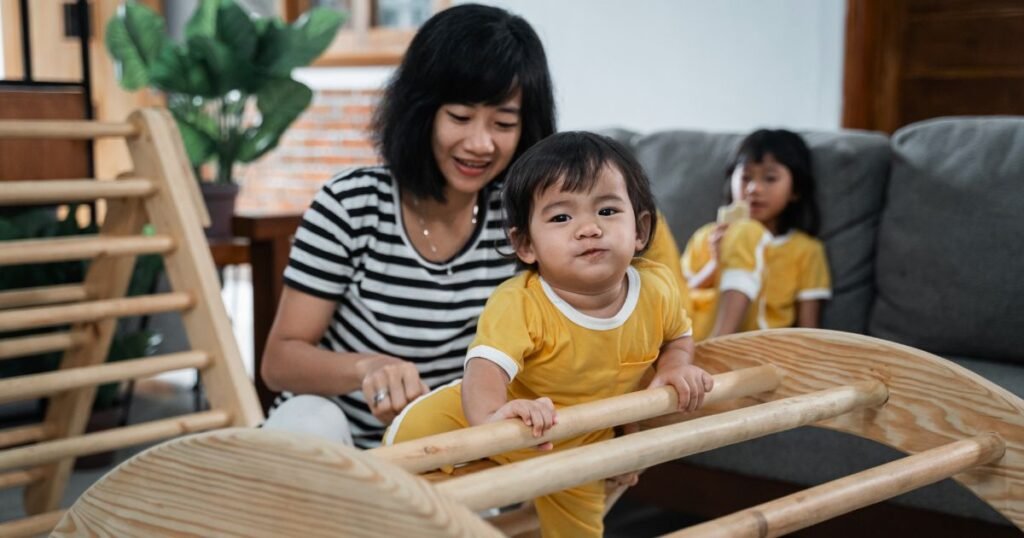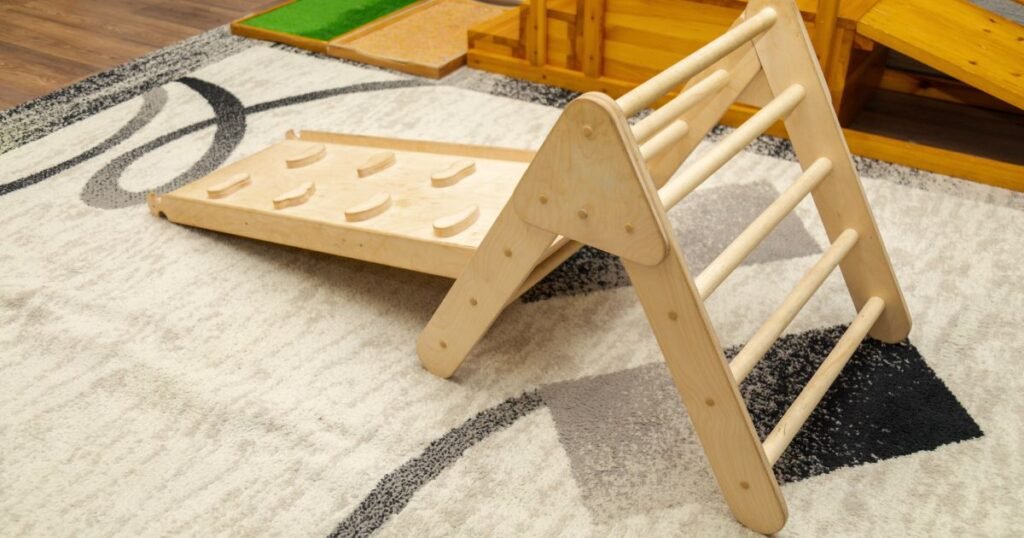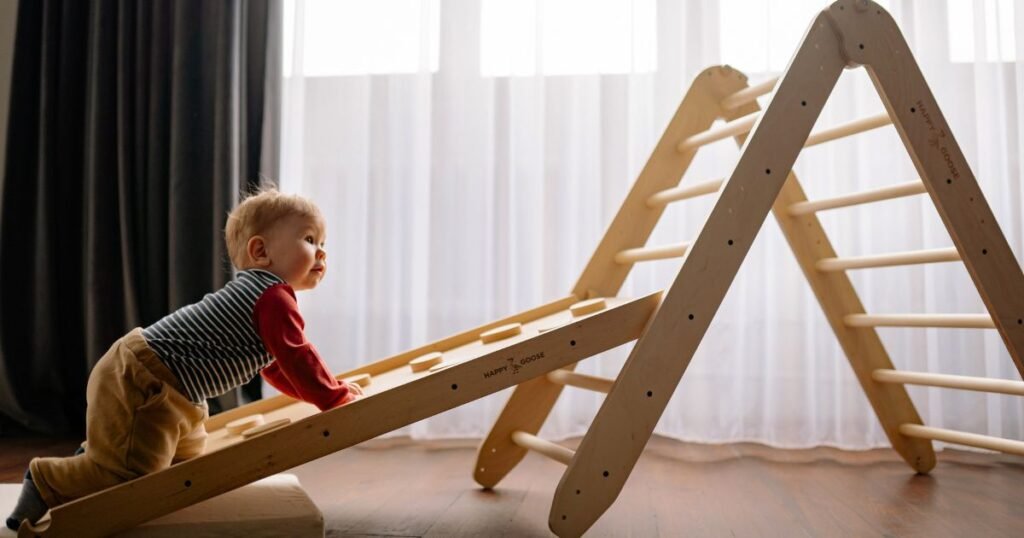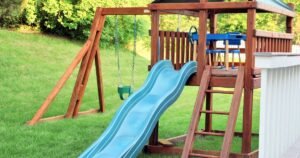Last Updated on 10 March 2024
This question often arises among parents seeking the best developmental tools for their little ones. The answer is yes. Montessori climbing toys are indeed useful to toddlers. Montessori climbing toys are a fun and engaging way to enhance your toddler’s physical development. These toys are designed to promote active play, improve motor skills, and foster independence in young children.
In this article, we will explore the benefits of Montessori climbing toys and how they can positively impact your toddler’s growth and development. We will also discuss how to choose the right climbing toy for your child, the importance of safety, and how to incorporate these toys into your toddler’s routine. Let’s dive in and discover why Montessori climbing toys are worth considering for your toddler’s playtime!
- What are Montessori Climbing Toys?
- The importance of Climbing in Child Development
- How to Choose the Right Montessori Climbing Toy for Your Toddler
- Safety When Using Montessori Climbing Toys
- Incorporating Montessori Climbing Toys into a Routine
- Are Montessori Climbing Toys Worth the Investment?
- FREQUENTLY ASKED QUESTIONS
What are Montessori Climbing Toys?
Montessori climbing toys are designed to help toddlers develop their motor skills, coordination, and balance. These toys are rooted in the philosophy of the Montessori method, which emphasizes independent play and hands-on learning. Montessori climbing toys provide an opportunity for young children to engage in active play, explore their physical abilities, and challenge themselves in a safe and supportive environment.
Montessori climbing toys are inspired by the teachings of Maria Montessori, an Italian physician and educator. The Montessori method is based on the belief that children learn best through self-directed, hands-on experiences. This philosophy emphasizes independent play, allowing children to explore and learn at their own pace.

In line with the Montessori philosophy, climbing toys provide young children with the opportunity to engage in independent play and physical exploration. These toys are designed to be open-ended, allowing children to use their imagination and creativity while interacting with them. Montessori climbing toys also support the development of gross motor skills, coordination, balance, and spatial awareness.
By incorporating climbing into playtime, toddlers can develop a sense of accomplishment as they overcome physical challenges and build confidence in their abilities. These toys encourage critical thinking, problem-solving, and the development of spatial awareness as children navigate the climbing structures. Additionally, climbing toys promote imaginative play, as children can transform the structures into various scenarios, such as mountains to climb, bridges to cross, or hideouts to explore.
Types of Montessori Climbing Toys
Montessori climbing toys come in various sizes and designs, catering to different needs and preferences. Here are some common types of Montessori climbing toys:
- Pikler Triangle Set: A Pikler triangle is a popular Montessori climbing toy consisting of a triangular frame with rungs that children can climb on. It allows children to safely explore climbing and develop strength, coordination, and balance.
- Climbing Ramp: A climbing ramp is another great option for young children. It provides a gentle incline for climbing, promoting balance and coordination.
- Climbing Triangle: Similar to the Pikler triangle, a climbing triangle offers additional climbing surfaces, such as ladders, slides, and climbing walls, for children to explore.
- Climbing Frame: A climbing frame is a larger structure that typically includes various climbing surfaces, such as ropes, nets, rock walls, and tunnels. It offers a more challenging and engaging climbing experience for older toddlers.
The importance of Climbing in Child Development
Climbing plays a vital role in the development of young children. It not only enhances physical development but also contributes to cognitive, social, and emotional growth. Let’s delve deeper into the various benefits climbing offers toddlers.
Physical Benefits of Climbing for Toddlers
Climbing helps toddlers develop strong muscles, coordination, and gross motor skills. As they climb, they engage their muscles, improving strength and endurance. The act of climbing requires coordination between hand and foot movements, enhancing spatial awareness and body control. Climbing also promotes active play, which is crucial for maintaining a healthy lifestyle and preventing sedentary habits. Encouraging toddlers to engage in physical activities, like climbing, sets a foundation for a lifetime of active behavior.
Mental and Emotional Benefits of Climbing for Toddlers
In addition to physical benefits, climbing provides toddlers with mental and emotional benefits. When children successfully climb, they gain a sense of accomplishment, boosting their self-esteem and confidence. Climbing challenges children to think critically, make decisions, and solve problems, as they navigate the climbing structures. It also enhances spatial awareness, as children learn to judge distances, angles, and heights. Furthermore, climbing encourages imaginative play, allowing children to create scenarios, use pretend play, and develop their creativity. By incorporating climbing into playtime, toddlers can experience a range of mental and emotional developmental benefits.
How to Choose the Right Montessori Climbing Toy for Your Toddler
When choosing a climbing toy for your toddler, it is essential to consider factors like age-appropriateness, weight capacity, and safety features. Here are some guidelines to help you select the right climbing toy for your little one:
Based On Age and Weight Capacity
The first consideration when selecting a climbing toy for your toddler is their age. Different climbing toys are designed for specific age ranges, and it is crucial to choose a toy that aligns with your child’s developmental abilities. Additionally, check the weight capacity of the climbing toy to ensure it can safely support your toddler’s weight. Consider your child’s current weight and growth potential to ensure the climbing toy will continue to be suitable as they grow. By selecting a climbing toy that is both age-appropriate and has an adequate weight capacity, you can provide a safe and engaging play experience for your toddler.
Based On Toddler’s Skills and Interests
Assessing your toddler’s skills and interests can guide you in selecting a suitable climbing toy. Every child develops at their own pace, so it is essential to consider their physical abilities, coordination, and level of comfort with climbing. For younger toddlers, choose climbing toys that offer support and stability, such as those with wider bases or lower heights. As your toddler grows and becomes more confident, you can gradually introduce more challenging climbing toys. Consider your child’s interest in climbing, their motor skills, and their desire to explore new skills. Observing your toddler during playtime can provide valuable insights into their engagement, enjoyment, and abilities, helping you choose the right climbing toy for them.
Based On Available Space and Safety
When choosing a Montessori climbing toy, it is important to take into account the available space in your home and prioritize safety. Consider the dimensions of the climbing toy and ensure that it fits well within the designated play area. If you have limited indoor space, you may opt for foldable or modular climbing toys that can be easily stored when not in use.

Safety should also be a top concern when selecting a climbing toy for your toddler. Look for climbing toys made from durable materials, such as thick wood, to ensure their stability and longevity. Avoid climbing toys with sharp edges or small parts that could pose a choking hazard. If you have an outdoor play area, make sure the climbing toy is suitable for outdoor use and can withstand different weather conditions. Regularly inspect the climbing toy for any wear and tear, addressing any maintenance or repair needs promptly to maintain a safe play environment for your child. By considering both space and safety, you can choose a climbing toy that provides a safe and enjoyable play experience for your toddler.
Safety When Using Montessori Climbing Toys
Ensuring the safety of your child during playtime is of utmost importance, especially when they are using climbing toys. By following safety guidelines and providing appropriate supervision, you can create a secure environment for your child to explore, learn, and play. Let’s explore the importance of supervision and safe play when using Montessori climbing toys, as well as the correct installation of the toy to further enhance safety measures.
Supervision and Safe Play
Caregivers should always supervise children while they are using climbing toys. Although Montessori climbing toys are designed with safety in mind, adult supervision ensures that children play within their abilities and in a controlled environment. Actively observing and engaging with your child during playtime not only ensures their safety but also allows you to provide guidance, encouragement, and support. If using climbing toys in a playground setting, it is still crucial to maintain close supervision, as each child’s abilities and challenges may vary. By supervising your child during playtime, you can help create a safe and positive experience with Montessori climbing toys.
Correct Installation of the Toy
Correct installation of the climbing toy is essential for maintaining safety. When setting up the toy, carefully follow the manufacturer’s instructions, ensuring that all connections and fastenings are secure. Double-check that the climbing toy is stable and can withstand the weight and movements of your child. Regularly inspect the toy for any signs of wear and tear, such as loose bolts, splinters, or damaged accessories, and address any maintenance needs promptly. Montessori climbing toys often feature thick wood frames, providing durability and stability. Proper setup and regular maintenance of the climbing toy will help ensure a safe and enjoyable playtime experience for your child.
Incorporating Montessori Climbing Toys into a Routine
Incorporating Montessori climbing toys into your toddler’s routine can enhance their playtime experiences and developmental growth. Balancing structured play and free play allows your child to engage in various types of play. Therefore supporting their physical, cognitive, and social-emotional development. Let’s explore the differences between structured play and free play when incorporating climbing toys and discover strategies for encouraging the regular use of these toys.
When planning play time for toddlers, it is essential to strike a balance between structured activities and free play. Offering open-ended opportunities allows children to unleash their creativity and explore without constraints. By incorporating games that encourage imagination, caregivers can nurture a child’s newfound abilities and cater to their individual needs. Mixing structured play with free play sessions not only enhances a child’s social skills but also fosters their cognitive and emotional development. Providing a blend of both types of play ensures a well-rounded experience that caters to the child’s age and interests, making it a great addition to their daily routine.
Tips for Encouraging Regular Use of the Toy
To encourage regular use of the Montessori climbing toy, consider the following tips:
- Make the toy easily accessible to your child, ensuring they can independently engage with it whenever they desire.
- Rotate different climbing toys or accessories to maintain your child’s interest and prevent playtime boredom.
- Praise and encourage your child’s efforts, providing positive reinforcement and celebrating their climbing achievements.
- Engage in play with your child, creating a bonding experience while increasing motivation and enjoyment.
- Set aside dedicated playtime for climbing activities, allowing your child to explore and develop their skills at their own pace.
- By implementing these tips, you can help your child develop a love for climbing and create a routine that incorporates regular playtime with their Montessori climbing toy.
Are Montessori Climbing Toys Worth the Investment?
If you are considering investing in a Montessori climbing toy for your toddler, you might wonder if it is worth the expense. Assessing the costs and benefits can help you make an informed decision about whether a climbing toy is a worthwhile investment for your child’s development. Let’s weigh the costs and benefits of Montessori climbing toys for toddlers.
Costs and Benefits of Montessori Climbing Toys for Toddlers
When conducting a cost-benefit analysis of Montessori climbing toys, it is essential to consider the developmental benefits they offer, as well as the cost of the toy itself.
In terms of developmental benefits, Montessori climbing toys provide numerous physical, cognitive, and social-emotional advantages for toddlers. From developing gross motor skills and coordination to enhancing imaginative play and problem-solving abilities, climbing toys play a crucial role in children’s overall development. By regularly engaging in climbing activities, children can improve their physical abilities, balance, and spatial awareness, while also fostering independence, confidence, and critical thinking skills.
When evaluating the cost of Montessori climbing toys, it’s important to consider their durability and longevity. Many of these toys are made from high-quality, durable materials, such as thick wood, which ensures they can withstand the active play of young children. Investing in a well-constructed climbing toy may offer years of use, making it a cost-effective option in the long run.
Additionally, Montessori climbing toys provide a great option for physical activity, especially when outdoor playtime is limited or climatic conditions are unfavorable. By offering a safe and engaging way for children to stay active, climbing toys prove valuable in promoting healthy physical development in toddlers.
Considering the developmental, durability, and physical activity benefits, the investment in a Montessori climbing toy for your toddler can be well worth it. However, it’s important to assess your budget, space availability, and your child’s individual needs and interests when making a purchasing decision.
In conclusion, Montessori climbing toys offer a unique way for toddlers to explore, develop physically, and build confidence. Understanding your toddler’s needs and interests is crucial to selecting the right climbing toy. Safety should always be a priority, ensuring proper supervision and installation. Encouraging regular use can enhance their motor skills and independence. While the investment may seem significant, the benefits of Montessori climbers for toddlers’ growth and development make them worthwhile. If you are looking to buy a Montessori climbing toy for your child, check out our top picks on the best climbing toys for your child. Happy climbing!









